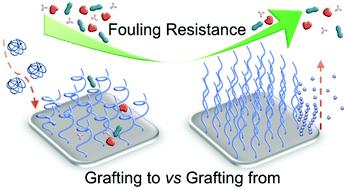当前位置:
X-MOL 学术
›
Polym. Chem.
›
论文详情
Our official English website, www.x-mol.net, welcomes your
feedback! (Note: you will need to create a separate account there.)
Grafting density and antifouling properties of poly[N-(2-hydroxypropyl) methacrylamide] brushes prepared by “grafting to” and “grafting from”
Polymer Chemistry ( IF 4.1 ) Pub Date : 2022-06-07 , DOI: 10.1039/d2py00478j Yu-Min Wang 1, 2 , Anna Kálosi 3, 4 , Yuriy Halahovets 4 , Iryna Romanenko 1, 2 , Jiří Slabý 5 , Jiří Homola 5 , Jan Svoboda 1 , Andres de los Santos Pereira 1 , Ognen Pop-Georgievski 1
Polymer Chemistry ( IF 4.1 ) Pub Date : 2022-06-07 , DOI: 10.1039/d2py00478j Yu-Min Wang 1, 2 , Anna Kálosi 3, 4 , Yuriy Halahovets 4 , Iryna Romanenko 1, 2 , Jiří Slabý 5 , Jiří Homola 5 , Jan Svoboda 1 , Andres de los Santos Pereira 1 , Ognen Pop-Georgievski 1
Affiliation

|
Antifouling polymer brushes are widely utilized in biomedical applications to prevent non-specific interactions with biological fluids. They consist of surface-tethered polymer chains and are commonly formed when the chains are “grafted to” (GT) a surface by chemisorption or “grafted from” (GF) a surface in a surface-initiated polymerization. Although the antifouling polymer brushes have been studied for years, an accurate comparison between the GT and GF methods in terms of the ability of the prepared brushes to resist fouling has not been established yet. In this study, we investigate physical and antifouling properties of poly[N-(2-hydroxypropyl) methacrylamide] (poly(HPMA)) brushes synthesized by GT and GF methods using reversible addition–fragmentation chain-transfer (RAFT) polymerization. Using size exclusion chromatography and single-molecule force spectroscopy, we are able to ensure that grafted polymer chains in the layers prepared by both methods have comparable composition and molar mass. Thus, we attribute the differences in fouling resistance and physical properties of the polymer layers to the physical conformation of the chains achieved by the selected grafting method. While both types of poly(HPMA) brushes are shown to substantially reduce fouling from blood plasma, the GF polymer brushes suppress fouling by an order of magnitude better than the GT polymer brushes. The observed difference in the antifouling performance is related to the much higher grafting density that can be achieved in the GF method. This study highlights the importance of the selection of the grafting method for achieving a high antifouling performance.
中文翻译:

“接枝到”和“接枝于”制备的聚[N-(2-羟丙基)甲基丙烯酰胺]刷的接枝密度和防污性能
防污聚合物刷广泛用于生物医学应用中,以防止与生物流体的非特异性相互作用。它们由表面束缚的聚合物链组成,并且通常在链通过化学吸附“接枝到”(GT)表面或在表面引发的聚合中“从”(GF)表面“接枝”时形成。尽管防污聚合物刷已被研究多年,但尚未确定 GT 和 GF 方法在制备的刷子的抗污能力方面的准确比较。在这项研究中,我们研究了 poly[ N-(2-羟丙基)甲基丙烯酰胺](聚(HPMA))刷子通过GT和GF方法使用可逆加成-断裂链转移(RAFT)聚合合成。使用尺寸排阻色谱和单分子力谱,我们能够确保通过两种方法制备的层中的接枝聚合物链具有相当的组成和摩尔质量。因此,我们将聚合物层的抗污染性和物理性质的差异归因于通过所选接枝方法实现的链的物理构象。虽然两种类型的聚 (HPMA) 刷子都显示出显着减少了来自血浆的污垢,但 GF 聚合物刷子对污垢的抑制效果比 GT 聚合物刷子好一个数量级。观察到的防污性能差异与在 GF 方法中可以实现的更高的接枝密度有关。本研究强调了选择接枝方法对于实现高防污性能的重要性。
更新日期:2022-06-07
中文翻译:

“接枝到”和“接枝于”制备的聚[N-(2-羟丙基)甲基丙烯酰胺]刷的接枝密度和防污性能
防污聚合物刷广泛用于生物医学应用中,以防止与生物流体的非特异性相互作用。它们由表面束缚的聚合物链组成,并且通常在链通过化学吸附“接枝到”(GT)表面或在表面引发的聚合中“从”(GF)表面“接枝”时形成。尽管防污聚合物刷已被研究多年,但尚未确定 GT 和 GF 方法在制备的刷子的抗污能力方面的准确比较。在这项研究中,我们研究了 poly[ N-(2-羟丙基)甲基丙烯酰胺](聚(HPMA))刷子通过GT和GF方法使用可逆加成-断裂链转移(RAFT)聚合合成。使用尺寸排阻色谱和单分子力谱,我们能够确保通过两种方法制备的层中的接枝聚合物链具有相当的组成和摩尔质量。因此,我们将聚合物层的抗污染性和物理性质的差异归因于通过所选接枝方法实现的链的物理构象。虽然两种类型的聚 (HPMA) 刷子都显示出显着减少了来自血浆的污垢,但 GF 聚合物刷子对污垢的抑制效果比 GT 聚合物刷子好一个数量级。观察到的防污性能差异与在 GF 方法中可以实现的更高的接枝密度有关。本研究强调了选择接枝方法对于实现高防污性能的重要性。











































 京公网安备 11010802027423号
京公网安备 11010802027423号